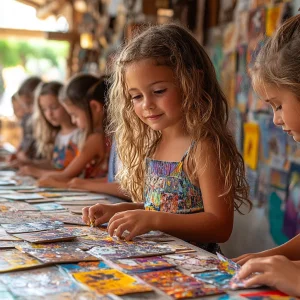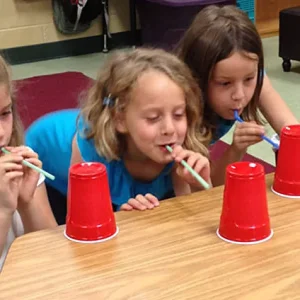Activity
Similar Activities
Musical Journey Through Time and Space - Instrument Exploration
Children’s Age: 3–4 years
Activity Duration: 15 minutes
Embark on a creative musical journey with children aged 36 to 48 months to boost their communication, self-care, and play skills. Use household items as instruments, set up a perfo…
Activity Duration: 15 minutes
Cultural Collage Celebration: Embracing Diversity Through Art
Children’s Age: 6–10 years
Activity Duration: 15 minutes
Explore and celebrate cultural diversity with the "Cultural Collage Celebration" activity designed for children. Enhance academic skills by creating a collaborative cultural collag…
Activity Duration: 15 minutes
Ecosystem Adventure Board Game - Nature's Quest
Children’s Age: 7–9 years
Activity Duration: 10 – 25 minutes
An interactive board game where children explore and learn about ecosystems through challenges and tasks.
Activity Duration: 10 – 25 minutes
Musical Kindness Quilt
Children’s Age: 8–10 years
Activity Duration: 10 – 20 minutes
The "Musical Kindness Quilt" activity engages 9-year-old children in learning about famous musicians while enhancing communication skills and cognitive development. Children choo…
Activity Duration: 10 – 20 minutes
Cosmic Conundrum Chefs: Space Word Problem Adventure
Children’s Age: 7–8 years
Activity Duration: 10 – 20 minutes
Let's play Space Word Problem Chefs! We'll use paper, pencils, and space-themed stickers to explore language and problem-solving. Set up a cozy spot, grab your supplies, and get re…
Activity Duration: 10 – 20 minutes
Enchanted Textures: Sensory Treasure Hunt Adventure
Children’s Age: 0 month – 6 years
Activity Duration: 5 – 10 minutes
Let's go on a Sensory Treasure Hunt adventure! We will explore different textures using our sense of touch. Gather textured items, hide them around the room, and guide the child to…
Activity Duration: 5 – 10 minutes
Enchanted Puppet Show: Creative Communication Adventure
Children’s Age: 0 month – 18 years
Activity Duration: 5 – 10 minutes
Let's have fun with the DIY Puppet Show activity! This activity helps kids improve communication skills and boosts creativity and social interaction. Gather materials like socks, g…
Activity Duration: 5 – 10 minutes
Sensory Texture Hunt for Developing Skills
Children’s Age: 4–7 years
Activity Duration: 5 – 10 minutes
Let's go on a Sensory Treasure Hunt! We will explore different textures like smooth stones, soft feathers, and rough sandpaper. You can use blindfolds for an extra challenge if you…
Activity Duration: 5 – 10 minutes
Magical Storytelling: Create Together with Friends
Children’s Age: 4–6 years
Activity Duration: 15 – 30 minutes
In the Create a Story Together activity, children will explore their creativity, language skills, and teamwork. Get small pieces of paper, colored pencils, and a container ready. K…
Activity Duration: 15 – 30 minutes
Whimsical Cup Blow Race for Kids
Children’s Age: 4–6 years
Activity Duration: 5 – 10 minutes
The Cup Race Challenge activity is designed to boost teamwork, fine motor skills, and problem-solving in children. You'll need plastic cups, straws, a table, and masking tape to cr…
Activity Duration: 5 – 10 minutes
Enchanted Sensory Bottles: Magical Discovery Journey
Children’s Age: 6 months – 1.5 years
Activity Duration: 10 minutes
Explore the world of sensory play with homemade sensory bottles designed for children aged 6 to 18 months. These engaging bottles support social-emotional and language development …
Activity Duration: 10 minutes
Space Odyssey Coding Adventure Game
Children’s Age: 6–18 years
Activity Duration: 0.5 – 1 hours
Let's go on a Space Adventure Coding Game! We'll use a cardboard spaceship, planets, stars, and coding cards with commands. Create a space atmosphere, place the coding cards, and e…
Activity Duration: 0.5 – 1 hours




























